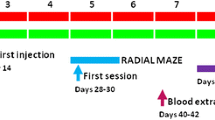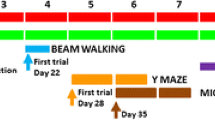Abstract
The NMDA type of glutamate receptors modulates learning and memory. Excessive activation of NMDA receptors leads to neuronal degeneration and death. Hyperammonemia and liver failure alter the function of NMDA receptors and of some associated signal transduction pathways. The alterations are different in acute and chronic hyperammonemia and liver failure. Acute intoxication with large doses of ammonia (and probably acute liver failure) leads to excessive NMDA receptors activation, which is responsible for ammonia-induced death. In contrast, chronic hyperammonemia induces adaptive responses resulting in impairment of signal transduction associated to NMDA receptors. The function of the glutamate-nitric oxide-cGMP pathway is impaired in brain in vivo in animal models of chronic liver failure or hyperammonemia and in homogenates from brains of patients died in hepatic encephalopathy. The impairment of this pathway leads to reduced cGMP and contributes to impaired cognitive function in hepatic encephalopathy. Learning ability is reduced in animal models of chronic liver failure and hyperammonemia and is restored by pharmacological manipulation of brain cGMP by administering phosphodiesterase inhibitors (zaprinast or sildenafil) or cGMP itself. NMDA receptors are therefore involved both in death induced by acute ammonia toxicity (and likely by acute liver failure) and in cognitive impairment in hepatic encephalopathy.
Similar content being viewed by others
References
Aguilar MA, Miñarro J, Felipo V (2000) Chronic moderate hyperammonemia impairs active and passive avoidance behavior and conditional discrimination learning in rats. Exp Neurol 161:704–713
Albrecht J, Dolinska M (2001) Glutamine as a pathogenic factor in hepatic encephalopathy. J Neurosci Res 65:1–5
Azorín I, Miñana MD, Felipo V, Grisolía S (1989) A simple animal model for hyperammonemia. Hepatology 10:311–314
Bernabeu R, Scmitz P, Faillace MP, Izquierdo I, Medina JM (1996) Hippocampal cGMP and cAMP are differentially involved in memory processing of inhibitory avoidance learning. Neuroreport 7:585–588
Bernabeu R, Schroder N, Quevedo J, Cammarota M, Izquierdo I, Medina JH (1997) Further evidence for the involvement of a hippocampal cGMP/cGMP-dependent protein kinase cascade in memory consolidation. Neuroreport 8:2221–2224
Blomgren K, McRae A, Bona E, Saido TC, Karlsson JO, Hagberg H (1995) Degradation of fodrin and MAP 2 after neonatal cerebral hypoxic-ischemia. Brain Res 684:136–142
Chen J, Zhang S, Zuo P, Tang L (1997) Memory-related changes of nitric oxide synthase activity and nitrite level in rat brain. Neuroreport 8:1771–1774
Corbalan R, Chatauret N, Behrends S, Butterworth RF, Felipo V (2002) Region selective alterations of soluble guanylate cyclase content and modulation in brain of cirrhotic patients. Hepatology 36:1155–1162
Danysz W, Zajaczkowski W, Parsons CG (1995). Modulation of learning processes by ionotropic glutamate receptor ligands. Behav Pharmacol 6:455–474
Erceg S, Monfort P, Hernández-Viadel M, Rodrigo R, Montoliu C, Felipo V (2005a) Oral administration of sildenafil restores learning ability in rats with hyperammonemia and with portacaval shunts. Hepatology 41:299–306
Erceg S, Monfort P, Hernandez-Viadel M, Llansola M, Montoliu C, Felipo V (2005b) Restoration of learning ability in hyperammonemic rats by increasing extracellular cGMP in brain. Brain Res 1036:115–121
Exposito I, Sanz B, Porras A, Mora F (1994) Effects of apomorphine and L-methionine-sulfoximine on the release of excitatory amino acid neurotransmitters and glutamine in the striatum of the conscious rat. Eur J Neurosci 6:287–291
Felipo V, Miñana MD, Grisolía S (1988) Long term ingestion of ammonium increases acetylglutamate and urea levels without affecting the amount of carbamyl phosphate synthase. Eur J Biochem 176:567–571
Felipo V, Grau E, Miñana MD, Grisolía S (1993) Ammonium injection induces an N-methyl-D-aspartate receptor-mediated proteolysis of the microtubule-associated protein MAP–2. J Neurochem 60:1626–1630
Forton DM, Thomas HC, Murphy CA, Allsop JM, Foster GR, Main J, Wesnes KA, Taylor-Robinson SD (2002) Hepatitis C and cognitive impairment in a cohort of patients with mild liver disease. Hepatology 35:433–439
Hawkins RA, Jessy J (1991). Hyperammonemia does not impair brain function in the absence of net glutamine synthesis. Biochem J 277:697–703
Hawkins RA, Miller AL, Nielsen RC, Veech RL (1973) The acute action of ammonia on rat brain metabolism in vivo. Biochem J 134:1001–1008
Hawkins RA, Jessy J, Mans AM, DeJoseph R (1993) Effect of reducing brain glutamine synthesis on metabolic symptoms of hepatic encephalopathy. J Neurochem 60:1000–1006
Hermenegildo C, Marcaida G, Montoliu C, Grisolía S, Miñana MD, Felipo, V (1996) NMDA receptor antagonists prevent acute ammonia toxicity in mice. Neurochem Res 21:1237–1244
Hermenegildo C, Montoliu C, Llansola M, Muñoz MD, Gaztelu JM, Miñana MD, Felipo V (1998) Chronic hyperammonemia impairs glutamate-nitric oxide-cyclic GMP pathway in cerebellar neurons in culture and in the rat in vivo. Eur J Neurosci 10:3201–3209
Hermenegildo C, Monfort P, Felipo V (2000) Activation of NMDA receptors in rat brain in vivo following acute ammonia intoxication. Characterization by in vivo brain microdialysis. Hepatology 31:709–715
Hindfelt B, Siesjo BK (1971) Cerebral effects of acute ammonia intoxication. Scand J Clin Lab Invest 28:365–374
Hindfelt B, Plum F, Duffy TE (1977) Effect of acute ammonia intoxication on cerebral metabolism in rats with portacaval shunts. J Clin Invest 59:386–396
Kosenko E, Kaminsky YG, Felipo V, Minana M-D, Grisolia S (1993) Chronic hyperammonemia prevents changes in brain energy and ammonia metabolites induced by acute ammonia intoxication. Biochim Biophys Acta 1180:321–326
Kosenko E, Kaminsky Y, Grau E, Miñana MD, Marcaida G, Grisolía S, Felipo V (1994) Brain ATP depletion induced by acute ammonia intoxication in rats is mediated by activation of the NMDA receptor and of Na/K-ATPase. J Neurochem 63:2172–2178
Kosenko E, Kaminsky Y, Grau E, Miñana MD, Grisolía S, Felipo V (1995) Nitroarginine, an inhibitor of nitric oxide synthetase, attenuates ammonia toxicity and ammonia-induced alterations in brain metabolism. Neurochem Res 20:451–456
Kosenko E, Felipo V, Montoliu C, Grisolia S, Kaminsky Y (1996) Effects of acute hyperammonemia in vivo on oxidative metabolism in nonsynaptic rat brain mitochondria. Metab Brain Dis 12:69–82
Kosenko E, Felipo V, Montoliu C, Grisolía S, Kaminsky Y (1997a) Effects of acute hyperammonemia in vivo on oxidative metabolism in nonsynaptic rat brain mitochondria. Metab Brain Dis 12:69–82
Kosenko E, Kaminsky Y, Kaminsky A, Valencia M, Lee L, Hermenegildo C, Felipo V (1997b) Superoxide production and antioxidant enzymes in ammonia intoxication in rats. Free Radic Res 27:637–644
Kosenko E, Kaminsky Y, Lopata O, Muravyov N, Kaminsky A, Hermenegildo C, Felipo V (1998) Nitroarginine, an inhibitor of nitric oxide synthase, prevents changes in superoxide radical and antioxidant enzymes induced by ammonia intoxication. Metab Brain Dis 13:29–41
Kosenko E, Kaminski Y, Lopata O, Muravyov N, Felipo V (1999) Blocking NMDA receptors prevents the oxidative stress induced by acute ammonia intoxication. Free Radic Biol Med 26:1369–1374
Kosenko E, Kaminsky Y, Stavroskaya IG, Felipo V (2000) Alteration of mitochondrial calcium homeostasis by ammonia-induced activation of NMDA receptors in rat brain in vivo. Brain Res 880:139–146
Kosenko E, Llansola M, Montoliu C, Monfort P, Rodrigo R, Hernandez-Viadel M, Erceg S, Sánchez-Perez AM, Felipo V (2003) Glutamine synthetase activity and glutamine content in brain: modulation by NMDA receptors and nitric oxide. Neurochem Int 43:493–499
Marcaida G, Felipo V, Hermenegildo C, Miñana MD, Grisolía S (1992) Acute ammonia toxicity is mediated by the NMDA type of glutamate receptors. FEBS Lett 296:67–68
Marcaida G, Kosenko E, Miñana MD, Grisolía S, Felipo V (1996) Glutamate induces a calcineurin-mediated dephosphorylation of Na+/K+-ATPase which results in its activation in cerebellar neurons in culture. J Neurochem 66:99–104
Meyer RC, Knox J, Purwin DA, Spangler EL, Ingram DK (1998) Combined stimulation of the glycine and polyamine sites of the NMDA receptor attenuates NMDA blockade-induced learning deficits of rats in a 14-unit-T-maze. Psychopharmacology 135:290–295
Miñana MD, Kosenko E, Marcaida G, Hermenegildo C, Montoliu C, Grisolía S, Felipo V (1997) Modulation of glutamine synthesis in cultured astrocytes by nitric oxide. Cell Mol Neurobiol 17:433–445
Miñana MD, Montoliu C, Llansola M, Grisolía S, Felipo V (1998) Nicotine prevents glutamate-induced proteolysis of the microtubule-associated protein MAP-2 and glutamate neurotoxicity in primary cultures of cerebellar neurons. Neuropharmacology 37:847–857
Monfort P, Corbalán R, Martinez L, López-Talavera JC, Córdoba J, Felipo V (2001) Altered content and modulation of soluble guanylate cyclase in the cerebellum of rats with portacaval anastomosis. Neuroscience 104:1127–1139
Monfort P, Muñoz MD, ElAyadi A, Kosenko E, Felipo V (2002) Effects of hyperammonemia and liver disease on glutamatergic neurotransmission. Metab Brain Dis 17:67–86
O’Carroll RE, Hayes PC, Ebmeier KP, Dougall N, Murray C, Best JJ, Bouchier IA, Goodwin GM (1991) Regional cerebral blood flow and cognitive function in patients with chronic liver disease. Lancet337(8752):1250–1253
Pantiga C, Rodrigo LR, Cuesta M, Lopez L, Arias JL (2003) Cognitive deficits in patients with hepatic cirrhosis and in liver transplant recipients. J Neuropsychiatry Clin Neurosci 15:84–89
Paulsen RE, Fonnum F (1989) Role of glial cells for the basal and Ca2+-dependent K+-evoked release of transmitter amino acids investigated by microdialysis. J Neurochem 52:1823–1829
Prickaerts J, Steinbusch HW, Smits JF, et al. (1997) Possible role of nitric oxide-cyclic GMP pathway in object recognition memory: effects of 7-nitroindazole and zaprinast. Eur J Pharmacol 337:125–136
Prickaerts J, De vente J, Ong W, et al. (2002) cGMP, but not cAMP, in rat hippocampus is involved in early stages of object memory consolidation. Eur J Pharmacol 436:83–87
Schenker S, McCandless DW, Brophy E, Lewis MS (1967) Studies on the intracerebral toxicity of ammonia. J Clin Invest 46:838–848
Smith S, Dringenberg HC, Bennett BM, et al. (2000) A novel nitrate ester reverses the cognitive impairment caused by scopolamine in the Morris water maze. Neuroreport 11:3883–3886
Weissenborn K, Heidenreich S, Giewekemeyer K, Ruckert N, Hecker H (2003) Memory function in early hepatic encephalopathy. J Hepatol 39:320–325
Yamada K, Hiramatsu M, Noda Y, Mamiya T, Murai M, Kameyama T, Komori Y, Nikai T, Sugihara H, Nabeshima T (1996) Role of nitric oxide and cyclic GMP in the dizocilpine-induced impairment of spontaneous alternation behaviour in mice. Neuroscience 74:365–374
Acknowledgements
This work was supported by grants from the Ministerio de Ciencia y Tecnología (SAF2002-00851 and SAF2005-06089) and from Ministerio de Sanidad (Red G03-155 and PI050253) of Spain and by grants from Consellería de Empresa, Universidad y Ciencia, Generalitat Valenciana (Grupos03/001, GV04B-055, GV04B-012, GVS05/082 and ACOMP06/005).
Author information
Authors and Affiliations
Corresponding author
Rights and permissions
About this article
Cite this article
Llansola, M., Rodrigo, R., Monfort, P. et al. NMDA receptors in hyperammonemia and hepatic encephalopathy. Metab Brain Dis 22, 321–335 (2007). https://doi.org/10.1007/s11011-007-9067-0
Published:
Issue Date:
DOI: https://doi.org/10.1007/s11011-007-9067-0




